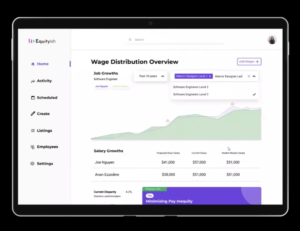Equityish: Pay Deserves an Analysis
For every $1 a white man earned in 2020, a woman made $.82, a black woman made $.62 and a latina woman made $.54. This data alone clearly demonstrates that a pay gap persists, a phenomena that we became determined to figure out and approach in a new way.
Story by Sydney Moore
After conducting research, we focused on utilizing a metric system to optimize pay equity and hold employers accountable. Our idea is that Equitish will calculate a candidate’s salary wage based on personalized metrics. For an organization to create a job posting they will have to fill out all relevant job information and fill in a questionnaire after each interview so that everyone’s perspective is weighed equally by the system. After that, salary suggestions will be generated. Equityish will even allow them to compare these suggestions to industry averages. Companies will also be able to use the Equityish badge on their job postings, which should increase the number of applicants because research indicates that people are more likely to apply to jobs that they perceive as equitable.

A prototyped version of how Equityish will allow employers to compare salary suggestions
Most of our team members – Leen Habbal, Catherine Lumanauw, and Christopher Jubinsky – had already worked together before IiA because we’re all in the same graduate program in the School of Information. We networked to add our teammate Tune Pawanrat, who proved to be a great addition because she has a business background while the rest of us have a UX and design backgrounds. We were all drawn to Innovation in Action (IiA), where we ended up receiving an honorable mention in the final showcase, because we came to Michigan with the goal of taking advantage of as many programs as possible. Yet, it was Catherine who specifically brought IiA to everyone’s attention, as she had already participated in it last year on the FooDEI team. For Tune, she originally signed up because she wanted to gain a better perspective of design after having worked for five years in Thailand prior to graduate school. Similarly, Chris wanted more experience designing outside of the classroom.

A team photo taken during one of our zoom meetings
What the Research Revealed
We concluded that the pay gap has two important sides: the candidate’s perspective, which already has a lot of solutions, and the organization’s perspective, which hasn’t been researched as much. More specifically, we came away with four important findings: minorities make less negotiations, there’s a lack of transparency in the hiring process, and there are no clear measurements of organizational accountability or compensation. Additionally, the feedback we received taught us how to more accurately predict our target audience’s prior knowledge. For instance, we sometimes forgot to explain concepts and terms because we knew the material so well. This led to gaps in our storytelling, logistics, and pitches.
However, if we could go back we would do a deeper dive of current solutions. It proved challenging to identify similar products already on the market so that we weren’t recreating the same thing as them. Part of the problem was that we tackled such a huge scope that it left many potential avenues open for innovation. A more thorough dive would have helped us figure out the core problem so that we could have been more innovative.
The Lessons we Learned
Tune said she was surprised by how different the school of thought was in IiA compared to her previous work. In her consulting background, she was encouraged to make assumptions, but this program taught her how to use open questions. She also realized the value of not jumping straight to the solution. Furthermore, since this topic is controversial, it was hard to figure out how we would make it work at the beginning. However, the process allowed us to deep dive into an important topic that will influence how we approach job interviews going forward. Leen said this was especially important to her because she’s constantly trying to educate herself as a woman and a minority. It makes her feel good that we created something which could provide some equality. And as best said by Patricia Arquette, “the issue of pay inequality is really important because experts say it will take forty years for that gap to close. We don’t have 40 years to wait.”
Future Directions

Equityish’s General Roadmap for the foreseeable future
We are still creating our plan for what’s next for Equityish, but we would eventually like to target midsize companies after we develop and pilot our product. If you’d like to follow along on our journey, watch our final IiA presentation for more details or check out our linkedin profiles: Leen Habbal, Catherine Lumanauw, Christopher Jubinsky, and Pawanrat (Tune) Pasawongse.



